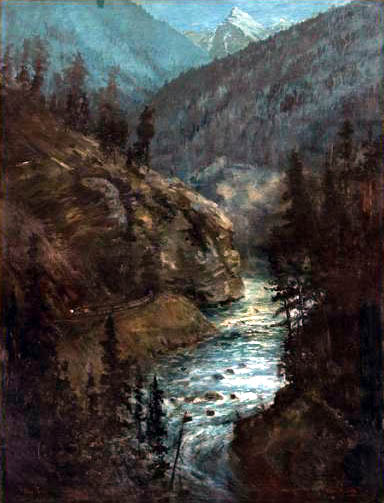
30 June 2009
CP Rail history Exhibited in Calgary

A depiction of Kicking Horse Pass by G.H.
Russell.
 Calgary Alberta - A small sample of the Golden
area's history is being featured in an art exhibit at Calgary's Glenbow Museum this summer.
Calgary Alberta - A small sample of the Golden
area's history is being featured in an art exhibit at Calgary's Glenbow Museum this summer.
The museum opened the exhibit "Vistas: Artists on the Canadian Pacific Railway" to the public on
20 Jun 2009. The exhibit features photographs and paintings from the nineteenth and twentieth centuries, during the
development of the railway into Western Canada.
The artists that are featured in the exhibit were hired by CPR to share the landscape that the rail had opened up with those living in
the East. The artists painted and photographed images of the mountains and countryside. This offered those living in Eastern Canada
and Europe a glimpse of what the railway could take them to in Western Canada.
"It is a collection of oil paintings, watercolours, and photographs, and covers the period from 1885 to 1915," said Roger
Boulet, the curator for the Vistas exhibit at the Glenbow Museum.
"All these paintings are in some way associated with the Canadian Pacific Railway and its promotion of the mountains, the Rockies,
and the Selkirks."
The railway was completed with the historical driving of the last spike in 1885. After this, the railway worked to increase the
tourism to the West. This was done by hiring artists to send images back East to show Canadians the beauty of the mountains.
"This was the era before postcards. The only way to see it was to get pictures," explained Boulet.
During the late 1800s, both Montreal and Toronto were the centre of the big arts scene in Canada. In 1880 the Royal Canadian Academy
of Arts was founded, and the institution began to hold annual exhibitions. It was at these exhibitions that the works depicting the
landscapes of the West were shown to those living in the East.
"There were beginning to be very prestigious annual exhibitions in both Toronto and Montreal at that time," said Boulet.
"If the artists came out West on passes, they would then paint the mountains and show them in exhibitions where the elite of
society would see them, or some said, the class that travelled."
The exhibit features the works of over 20 Canadian artists, which have been gathered from Glenbow's collection, as well as public and
private collections. This is the first time that these 130 pieces have been brought together for an exhibit.
There were a number of key spots along the route that artists captured. Most of the pictures that are in the exhibit that portray the
area close to Golden were taken by William M. Notman. The majority of these are from Field, which was one of the key spots for the
artists, and the location of Mount Stephen House, one of the first three hotels that were built by CP Rail. Two other key spots were
Glacier and Fraser Canyon.
"The goal was really Glacier. That's what they would refer to as the climax of mountain scenery," said Boulet. "Fraser
Canyon House, Mount Stephen House, and Glacier House were all built on the same design, and they were the first hotels that the
railway built."
A book has also been published along with the exhibit. Among other things, the book shows how the railway changed what photographs
were coming out of the West. Instead of images from the Gold Rush that were taken by artists from the West, the images were captured
of the landscape by artists visiting from the East.
"There is a 192 page book that accompanies the show, and that pretty well documents the whole thing," said Boulet. "The
book is slightly different in that it shows the changing perception of British Columbia from when the first photographs appear to when
the railway arrives."
Megan McKinnon.
|
|